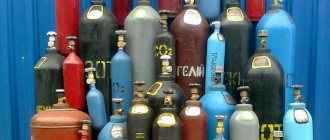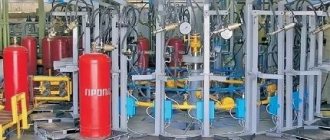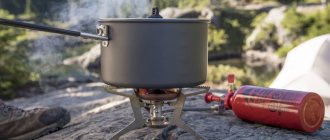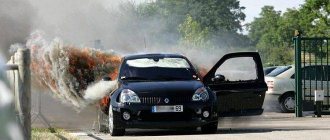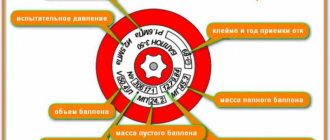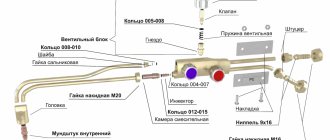Working with technical gases requires strict adherence to the operating rules for gas-using equipment and gas tanks, which must be periodically certified. It is important to understand that routine inspection of cylinders is not a whim of regulatory authorities, but a necessary measure for the timely detection of design defects and the prevention of dangerous situations in production.
There are many private companies supplying technical gases that, neglecting the certification procedure, provide customers with expired cylinders. When receiving a cheaper product, the buyer is often unaware of the possible consequences. Read the article about the dangers of operating uncertified tanks: gray producers of technical gases.
At the same time, responsible organizations take care of the safety of their clients by fulfilling the requirements of the Federal Tax Service, which relate to the arrangement of testing points for the inspection of cylinders. To obtain permission from regulatory authorities to conduct tests, the company must have:
- a room of suitable size;
- technical means;
- certified specialists;
- stamp with the organization code;
- production instructions.
Checking the gas cylinder
Inspection of a gas cylinder is an event that is necessary primarily for its owner. The inspection can ensure that the cylinder is safe to use and can be used for its intended purpose, otherwise their operation is unacceptable. There is a uniform inspection procedure; during its implementation, the surfaces of the cylinders are inspected to detect surface damage.
Gas cylinder service life
They check the quality of markings and painting for compliance with GOST requirements and the condition of the crane. In addition, during the certification process, hydraulic tests of gas storage tanks are carried out. The results of the inspection and tests performed are recorded in the passport that accompanies the product throughout its operation.
Without such measures, the refueling and operation of gas storage and transportation tanks is unacceptable. The examination of cylinders and the issuance of an opinion on them can only be carried out by an organization that has all the necessary permits and authorities from the relevant state supervisory authorities.
Gas storage vessels must be certified once every few years. The duration of the procedure depends on several parameters - on the material, for example, if the cylinders are made of alloy or carbon steel, then they only need to go through this procedure once every five years. Cylinders installed on vehicles as part of LPG must undergo certification within three or five years.
Cylinders that operate in stationary conditions and are intended for storing inert gases undergo the necessary inspections once every ten years.
The specified inspection periods must be strictly observed. It's all about safety. If containers are intended for storing and transporting propane, acetylene or other explosive gas, any defect on the outer surface of the cylinder can lead to irreparable consequences.
As soon as doubts arise about the performance of a gas storage tank, it is necessary to remove it from circulation and purchase or rent a new one.
How much does it cost to re-examine cylinders and check gas equipment on a car?
The price of verification depends on the volume and type of vessel, but on average in the market it starts at 1,200 rubles. Additional operations may affect the final cost:
- Dismantling/installation;
- degassing;
- cleaning/washing;
- primer, painting;
- minor repairs or restoration of the cylinder.
Thus, the cost can reach up to 7,000 rubles per cylinder. Which will often exceed the purchase price of a new container.
A scheduled inspection of gas equipment costs about 500 rubles, here everything also depends on the model of equipment, brand of machine, and elimination of identified problems.
It is worth noting that all procedures take 1-3 days if done according to legal requirements.
Many legitimate service shops will charge the customer a fee and perform a formal inspection of the equipment. Here everyone chooses for themselves.
Frequency of checking the validity of cylinders
Transportation and operation of technical gases is associated with significant danger. This is due not so much to their explosiveness or flammability, but rather to the presence of high pressure in the vessels intended for their storage and delivery to the point of consumption.
Under such conditions, even the smallest defect can cause a serious accident. That is why timely inspection and necessary maintenance of cylinders plays a huge role.
Refilling propane cylinders
The maximum design operating pressure of cylinders with compressed gases heated to t + 50 ° C. In the formula for calculating this parameter for dissolved and compressed volatile elements, t + 20 ° C is considered. When the cylinder is heated under the influence of external factors above the specified temperature indicators, the pressure on the walls increases. Exceeding the permissible limits is a risk of damage to the cylinder, gas leakage and all the ensuing consequences.
Attention! Regardless of the correct filling procedure, quickly opening the valve will lead to a higher gas pressure than provided for by the design of the cylinder. As a result, the temperature of the gas will increase.
The process of inspection and restoration of containers for industrial gases
Regulatory documentation, namely the “Rules for the Arrangement and Operation of Vessels...” stipulates the regularity of inspection of the technical condition of gas vessels.
Rules for using acetylene cylinders
For example, inspection of acetylene cylinders is carried out once every five years. While the mass inside the cylinder must be checked at least once every 2 years. By the way, on the cylinder there must be a mark indicating the timing of the inspection, the result of the inspection of the porous mass, and the timing of the next inspection of the cylinder.
In accordance with the technical conditions, only those containers that have passed all the necessary tests and all relevant records have been made are allowed for operation. New vessels undergo the necessary test cycle during product acceptance by the technical control service.
After the expiration of the inspection period, the cylinders must undergo re-examination, that is, a full inspection of the technical condition. At the same time, those that have not passed the re-examination must be withdrawn from circulation and sent for recycling (disposal).
Tanks on which correctable defects are found are subject to repair and, after completing the required work and conducting proper tests, can be returned to operation.
When is gas tank certification performed?
The frequency of technical certification for vessels operating under excess pressure is 5 years. That is, from the date of manufacture, every 5 years the cylinder must be subjected to tests, during which the integrity of the body and valve, the weight of the structure, the internal capacity and the ability to withstand increased pressure are determined.
However, in some situations, the survey is performed earlier than the deadline, when:
- valve is broken;
- a leak was detected at the cylinder-valve connection;
- the ring on the neck is faulty or missing;
- shoe damaged;
- The painting of the outer surface is of poor quality.
The decision to repair or discard such vessels is made only based on the results of a visual inspection and technical studies.
The procedure for carrying out regular tests of cylinders
Regular tests of cylinders are carried out in accordance with RD 03112194-1094-03 and RD 03112194-1095-03. Employees who perform such work must undergo appropriate training and have the appropriate knowledge and skills.
The next tests are carried out in the following sequence:
- Acceptance of containers. At this stage of the inspection, the completeness of the cylinder is checked and the external surface is inspected. At the same time, the date of the last inspection and pressure testing is checked. If necessary, the inner surface of the container must be cleaned.
- Inspection of the inside of the container is carried out using specialized equipment.
- The fittings are dismantled and inspected. In addition, during the inspection process, technological parts can be installed, without which it is impossible to conduct hydraulic tests.
After hydraulic testing (pressure testing), it is necessary to dry the vessel from traces of the reagent. Return the dismantled fittings to their place.
The cylinder must be prepared for priming and painting. To do this, it is sandblasted. After applying a coating of the appropriate color and drying it on the surface of the cylinder, it is necessary to carry out marking in accordance with regulatory documentation. The completion of the survey work is documented by a corresponding act. The total time to complete all of the above work is 3 – 5 hours. This time includes both preparatory and main operations.
Service life from manufacturers
Metal-composite MKB and BMK serve up to 10 years without additional examinations.
The key date for the products of the Chelyabinsk Pipe Rolling Plant is December 22, 2014. Equipment manufactured before this date has a shelf life of up to 40 years, and equipment manufactured after this date has a maximum shelf life of 20 years.
Aluminum BD containers last up to 10 years if manufactured before 11/2014, and up to 20 years if manufactured later.
In this article you will find out whether safety helmets have an expiration date.
Storage rules
Cylinders intended for technical gases are stored on the basis of safety requirements, which are defined in the “Rules for the operation of pressure vessels PB 03-576-03”.
Cylinder storage
In particular, all workers and engineering personnel must undergo proper theoretical and practical instruction. Vessels containing gas are stored either in separate rooms (buildings), or they can be stored in open space, but in this case, they must be protected from exposure to precipitation and sun.
Meanwhile, storing containers with oxygen and flammable gases in the same room (building) is prohibited!
Gas containers can be installed, for further operation, no closer than one meter to heat sources. If open fire is used for heating, the distance to the cylinder should not be less than 5 meters.
GOSTs and deadlines
The manufacturer is obliged to independently set the service life, but in any case, excess service is unacceptable.
This is confirmed by clause 485 of the Safety Rules for hazardous production facilities using pressure equipment, approved by Rostekhnadzor (Order No. 116 of March 25, 2014).
Some containers can last up to 40 years, but they are all manufactured to strict standards.
In particular, GOST 15860-84 regulates the production of “welded steel cylinders for liquefied hydrocarbon gases under pressure up to 1.6 MPa.”
According to the standard, if all rules are followed and inspections are completed every 5 years, the tanks can be used for 40 years .
When manufacturing aluminum databases, they are guided not by GOST, but by technical conditions, their use is certified. Steel vessels are often manufactured according to GOST 949-73 with a two-year warranty period.
Read here about how long cement can be stored.
At the same time the operational period , in contrast to the warranty period, can extend for 20 years, which is confirmed by GOST R ISO 11439-2010, which regulates the refueling of vehicles (clause 4.3.1).
Types and design of valves
Despite the fact that all cylinders for storing and transporting gases differ from each other in shape, coating color, volume and many other characteristics, they all have the same design. The cylinder includes a faucet, a tank, etc. Faucets may differ from each other in design features and materials that were used for their production. In addition, they are divided by type of application - some are used for oxygen, others for propane, and others for acetylene. Accordingly, the following type of coatings are applied to their surface:
- blue;
- red
- white.
Gas cylinder valves
A typical gas tap consists of:
The body is made in the form of a tee, consisting of three fittings, each of them has a thread. On some models, a safety valve is built into the housing. The main task of this device is to relieve excess pressure that has arisen in the cylinder.
A fitting located at the bottom designed to connect the valve to a gas storage tank. A regulating flywheel (steering wheel) is attached to the top one. External communications are connected to the side fitting or gas is injected. The body and main parts are made of brass or steel.
Valves used for non-flammable gases are made with a right-hand thread on the fittings, for those used for flammable gases, a left-hand thread is cut.
Gas cylinder valve repair
Main malfunctions of gas taps
In fact, the design of the gas tap is not complicated and there is nothing particularly broken in it. But nevertheless, for a number of reasons, it can either begin to leak gas or completely fail. One of the reasons for its breakdowns is negligence on the part of the staff. For example, applying excessive force when opening or closing. This can lead to either thread stripping or rod breakage.
In addition, foreign particles entering the regulator may prevent the valve from closing completely, which will inevitably lead to a gas leak. In any case, at the slightest suspicion of defects in the body or mechanism of the gas tap, the cylinder must be removed from the workplace or household premises and sent for repair.
Yes, undoubtedly, you can remove the gas valve from the cylinder and inspect it yourself and, if necessary, blow it out or repair it, but we must not forget that any work with a gas cylinder carries a potential danger. That is why there is a strict ban on dismantling gas taps on your own in makeshift conditions. If there is even a small opportunity to transfer the repair of the gas tap to a workshop, then it is better to do so.
Stages of the examination procedure
The rules for conducting inspections of gas cylinder installations conditionally subdivide the entire procedure into certification of equipment, as well as its pressure testing and testing.
- the equipment is subjected to an external inspection, the stated expiration dates are checked and the date of the next test is determined;
- if necessary, dismantle the HBO cylinder;
- clean the equipment from possible contamination, wash it and bleed the gas;
- certification is carried out directly, which consists of conducting checks for the suitability of the equipment for further safe operation, checking its compliance with established norms and standards, and also inspecting for the presence of defects;
- if surface defects in the form of corrosion are detected, the surface is cleaned and painted with preliminary priming;
- Crimping of gas cylinders is carried out, which consists of diagnosing the equipment for its complete tightness and degree of strength;
- the final stage is the inspection of the HBO cylinder itself, based on the results of which a mark is placed and a corresponding entry is made in the technical documentation;
- If the cylinder was removed from the car, it must be reinstalled.
HBO certification procedure
The essence of certification is to conduct tests that should determine the compliance of equipment with approved norms and standards. They start with a thorough visual analysis of the condition of the internal and external surfaces of the installation.
All elements of the installation that show visible defects in the form of corrosion spots, chips and scratches are rejected. They are unsuitable for subsequent operation in this form; in this case, the HBO cylinder will need to be replaced. For the next stage of the procedure - pressure testing of HBO cylinders - equipment with the following indicators is allowed:
- the detected defects have a depth of no more than 10% of the wall thickness;
- the total surface area exposed to corrosion processes is no more than 10% of the equipment area.
Cylinders may be allowed for subsequent use if the corrosion spots on them do not pose a danger to the normal functioning of the vessel on the vehicle. Moreover, before performing pressure testing, such cylinders must be cleaned, treated with a primer and painted. After this, the corresponding technical inscription is performed.
Gas pressure testing process
Pressure testing of gas cylinders is carried out to check the water tightness and strength of the installation elements. Water resistance is checked as follows: all air is pumped out of the vessel being tested and the entire volume is filled with water. Pressure is then applied to the filled vessel. This test determines whether the container is completely sealed. After the test, it must be dried.
Air testing of equipment is also used. To do this, the cylinder is lowered into water for 2 minutes and, using inert gas or compressed air, which is previously filled into the vessel under a pressure of 16 atmospheres, it is checked. The point is that one gas can be replaced by another.
If bubbles appear on the surface of the water within the specified time, this is evidence of depressurization of the cylinder. Depending on the extent of damage, such a vessel is replaced with a new one or repaired and then re-inspected.
Only successfully completed pressure testing of methane cylinders provides grounds for their installation on vehicles and subsequent operation. Such equipment is submitted for inspection, during which a stamp is affixed and the necessary data is entered into the technical passport.
Procedure for checking a HBO cylinder
Inspection of propane and methane equipment is intended to confirm the fact that this vessel fully complies with current requirements and standards and is completely safe for further operation.
Based on the results of the completed testing, a note is made in the technical documentation regarding permission for admission and further use of the installation on a vehicle. In the documents with which each gas cylinder installation is equipped, a note is made that the gas cylinder has passed external and internal inspection, as well as all the prescribed tests. Based on them, a conclusion is issued on the suitability of the unit for operation.
Such a document, namely a certificate in Form 2B, must always be present in the vehicle. It may be required during inspection by traffic police officers, in case of vehicle maintenance, as well as in case of issuing a diagnostic card. In addition, some gas stations may also require the presentation of this certificate. They also mark the cylinder itself, applying the mark of the point that performed the test, the date it was carried out and the date of the next regular test. The stamp is made in one line in Arabic numerals of a certain height.
Replacement Precautions
Replacing the valve on a gas cylinder must be carried out in compliance with certain safety measures, including the following:
Replacing the gas cylinder valve
- Remove any remaining gas from the vessel. It is permissible to release gas only in an open space. An exception can be made only for nitrogen, oxygen and a number of others.
- The workplace where work will be performed must be well ventilated.
- The flywheel must be unscrewed smoothly and at low speed.
- The valve can be replaced only after equalizing the pressure outside and in the cylinder.
When installing the valve in its original place in the cylinder, it is necessary to use fum tape and other types of sealants that ensure a reliable connection. It should be noted that seals of any type can create certain difficulties when removing the valve. To make this task easier, it is permissible to use a hair dryer.
It is permissible to heat the fittings installed on the cylinder only after emptying the contents of the container.
How to identify a carbon dioxide cylinder?
The carbon dioxide cylinder is painted black. The inscription “Carbon dioxide” or “CO2” is yellow. In addition to the inscription, passport data about it is applied to the cylinder.
Interesting materials:
Why do you need to study until 11th grade? Why do you need to record moves in chess? Why do you need an iron bucket in KFS? What are attributes used in HTML? What are finger cuffs for? Why are scientific reserves needed? What are the orange balls on the wires for? What are sika deer antlers used for? What are pistils and stamens for? What are OGE's results needed for?
Step-by-step instructions for replacing the valve
The new control valve is not fixed to the cylinder with a clean thread. It is imperative to use sealing materials: sealants or fum tape.
Checking tightness and completing work
Upon completion of work to replace the valve on the gas vessel, it is necessary to check the tightness of the newly assembled connections. To do this, they use a method that has been proven for decades - applying soap foam.
Checking tightness and completing work
If the joints are assembled poorly, then bubbles will form at the point of gas leakage and therefore work will need to be done to reassemble them anew.
The process of checking HBO on a car
After installing and connecting the cylinder to the car, the gas cylinder equipment is checked, which includes:
- checking the tightness of the system under pressure;
- adjusting the operation of gas equipment;
- CO, CH content of exhaust (smoke in diesel engines).
Based on the test results, a certificate of periodic testing of the gas equipment (form 2b) installed on the vehicle is issued.
Why repair a gas cylinder?
Whether or not to repair gas cylinders is determined at the stage of their inspection. During the inspection process, the external and internal cavities of the cylinder are examined.
Places for inspection in gas cylinders during inspection
In addition, the condition of the support shoe is inspected; if its condition is not capable of ensuring vertical installation of the cylinder, then it is unacceptable to operate it.
Which vessels are subject to discarding?
There are signs by which cylinders are rejected during examination:
- mechanical damage to the case, traces of impacts;
- reduction in measured weight by 7.5% or more compared to the passport value;
- increase in measured volume by 1% compared to the passport volume;
- leaked or leaked liquid during hydraulic pressure testing;
- missing or unreadable data on the nameplate.
Such containers are considered defective and are not allowed for further use. They are also not subject to repair. To eliminate possible attempts to force them to continue working, the neck thread on them is destroyed and a hole is drilled in the wall .
Timely inspection of gas containers is the key to their safe operation. For such an examination it is necessary to involve organizations that have passed state certification.
